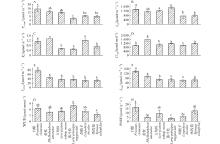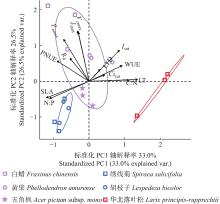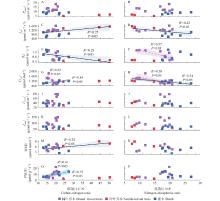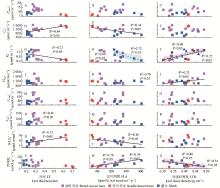

Scientia Silvae Sinicae ›› 2023, Vol. 59 ›› Issue (7): 12-23.doi: 10.11707/j.1001-7488.LYKX20220864
• Frontier & focus: Functional traits of woody plants • Previous Articles Next Articles
Xinyue Liu1,2( ),Liping Wang3,Chunhe Liu3,Yanli Sun4,Xiaoshuai Wei1,2,Mingze Xu1,2,Cong Han1,2,Yun Tian1,2,Xin Jia1,2,Tianshan Zha1,2,*(
),Liping Wang3,Chunhe Liu3,Yanli Sun4,Xiaoshuai Wei1,2,Mingze Xu1,2,Cong Han1,2,Yun Tian1,2,Xin Jia1,2,Tianshan Zha1,2,*( )
)
Received:2022-12-06
Online:2023-07-25
Published:2023-09-08
Contact:
Tianshan Zha
E-mail:15650700181@163.com;tianshanzha@bjfu.edu.cn
CLC Number:
Xinyue Liu,Liping Wang,Chunhe Liu,Yanli Sun,Xiaoshuai Wei,Mingze Xu,Cong Han,Yun Tian,Xin Jia,Tianshan Zha. Variation and Adaptation Strategies in Leaf Traits of Main Woody Plants in the Larix principis-rupprechtii Community in Baihua Mountain, Beijing[J]. Scientia Silvae Sinicae, 2023, 59(7): 12-23.
Table 1
The information of main woody species in sample plot"
| 物种 Species | 郁闭度/盖度 Crown density/ coverage (%) | 平均树高 Average height/m | 平均胸径 Average diameter at breast height/cm |
| 华北落叶松 Larix principis-rupprechtii | 43 | 19.83 | 23.01 |
| 白蜡 Fraxinus chinensis | 43 | 12.57 | 31.57 |
| 黄檗 Phellodendron amurense | 43 | 7.67 | 9.33 |
| 五角枫 Acer pictum subsp. mono | 43 | 15.06 | 19.63 |
| 胡枝子 Lespedeza bicolor | 12.6 | 1.27 | 2.00 |
| 绣线菊 Spiraea salicifolia | 7.2 | 0.96 | 3.22 |
Table 2
Leaf traits and interspecific variation coefficient across most common woody plant species in Baihua Mountain"
| 性状 Traits | 平均值(±标准差) Mean (±SD) | 最大值 Max. | 最小值 Min. | 变异系数 Coefficient variation(%) |
| 最大净光合速率Maximum net photosynthetic rate(Pnmax)/(μmol·m?2s?1) | 10.40±0.83 | 18.42 | 4.99 | 32.96 |
| 饱和光强Saturation irradiance(Isat)/(μmol·m?2s?1) | 1131.63±74.44 | 1649.31 | 561.89 | 27.12 |
| 暗呼吸速率Dark respiration rate(Rd)/(μmol·m?2s?1) | 0.90±0.09 | 1.42 | 0.47 | 39.10 |
| 饱和胞间二氧化碳浓度Saturation intercellular CO2 concentration (Cisat)/(μmol·mol?1) | 1176.06±52.78 | 1843.73 | 908.90 | 18.50 |
| 最大羧化速率Maximum rate of carboxylation(Vcmax)/(μmol·m?2s?1) | 44.17±3.86 | 80.45 | 24.63 | 36.00 |
| 最大电子传递速率Maximum potential rate of electron transport(Jmax)/(μmol·m?2s?1) | 83.93±6.86 | 148.82 | 51.16 | 33.69 |
| 水分利用效率Water use efficiency(WUE)/(μmol·mmol?1) | 5.60±0.42 | 9.31 | 2.17 | 32.08 |
| 光合氮利用效率Photosynthetic nitrogen-use efficiency(PNUE)/(μmol·g?1s?1) | 8.88±1.27 | 22.88 | 2.71 | 60.88 |
| 碳氮比Carbon-nitrogen ratio(C∶N) | 22.01±2..35 | 50.30 | 13.00 | 48.03 |
| 氮磷比Nitrogen-phosphorus ratio (N∶P) | 16.76±1.28 | 27.00 | 7.49 | 34.37 |
| 叶厚Leaf thickness (LT/mm) | 0.33±0.0.4 | 0.71 | 0.17 | 36.98 |
| 比叶面积Specific leaf area(SLA)/( cm2·g?1) | 205.58±22.27 | 405.73 | 66.30 | 56.83 |
| 叶组织密度Leaf tissue density(LTD)/( g·cm?3) | 0.39±0.01 | 0.49 | 0.30 | 32.61 |

Fig.1
Photosynthetic traits of the most common woody plant species in a Larix principis-rupprechtii community A: Maximum net photosynthetic rate, Pnmax; B: Saturation irradiance, Isat; C: Dark respiration rate, Rd; D: Saturation intercellular CO2 concentration, Cisat; E: Maximum rate of carboxylation, Vcmax; F: Maximum potential rate of electron transport, Jmax; G: Water use efficiency, WUE; H: Photosynthetic nitrogen-use efficiency, PNUE. The different lowercase letters indicate significantly different photosynthetic traits among species."

Table 3
Correlations between leaf traits in a Larix principis-rupprechtiicommunity"
| 氮磷比 Nitrogen-phosphorus ratio(N∶P) | 叶厚 Leaf thickness (LT) | 比叶面积 Specific leaf area(SLA) | 叶组织密度 Leaf tissue density(LTD) | |
| 碳氮比 Carbon-nitrogen ratio(C∶N) | ?0.40 | 0.26 | ?0.04 | ?0.33 |
| 氮磷比 Nitrogen-phosphorus ratio(N∶P) | — | ?0.63** | 0.63** | ?0.24 |
| 叶厚 Leaf thickness(LT) | — | — | ?0.72** | ?0.11 |
| 比叶面积 specific leaf area(SLA) | — | — | — | ?0.52* |

Fig.4
Principal component analysis of leaf traits in a Larix principis-rupprechtii community Which Pnamx is maximum net photosynthetic rate, Isat is saturation irradiance, Rd is dark respiration rate,Cisat is saturation intercellular CO2 concentration, Vcmax is maximum rate of carboxylation, Jmax is maximum potential rate of electron transport, C∶N is carbon-nitrogen ratio, N∶P is nitrogen-phosphorus ratio, LT is leaf thickness, SLA is specific leaf area, LTD is leaf tissue density, WUE is water use efficiency, and PNUE is photosynthetic nitrogen-use efficiency."


Fig.5
Relationships between photosynthetic traits and chemical traits in a Larix principis-rupprechtii community Pnamx is maximum net photosynthetic rate, Isat is saturation irradiance, Rd is dark respiration rate,Cisat is saturation intercellular CO2 concentration, Vcmax is maximum rate of carboxylation, Jmax is maximum potential rate of electron transport, WUE is water use efficiency, and PNUE is photosynthetic nitrogen-use efficiency."


Fig.6
Relationships between photosynthetic traits and structural traits in a Larix principis-rupprechtii community Which Pnamx is maximum net photosynthetic rate, Isat is saturation irradiance, Rd is dark respiration rate,Cisat is saturation intercellular CO2 concentration, Vcmax is maximum rate of carboxylation, Jmax is maximum potential rate of electron transport, WUE is water use efficiency, and PNUE is photosynthetic nitrogen-use efficiency."

|
曹嘉瑜, 刘建峰, 袁 泉, 等. 森林与灌丛的灌木性状揭示不同的生活策略. 植物生态学报, 2020, 44 (7): 715- 729.
doi: 10.17521/cjpe.2020.0024 |
|
|
Cao J Y, Liu J F, Yuan Q, et al. Traits of shrubs in forests and bushes reveal different life strategies. Chinese Journal of Plant Ecology, 2020, 44 (7): 715- 729.
doi: 10.17521/cjpe.2020.0024 |
|
| 曹敬婷, 朱师丹, 文 印, 等. 润楠属广布种和狭域种幼苗生理生态特征. 植物科学学报, 2016, 34 (5): 790- 797. | |
| Cao J T, Zhu S D, Wen Y, et al. Eco-physiological traits of leaves from basal angiospermMachilus species with localized and widespread distribution . Plant Science Journal, 2016, 34 (5): 790- 797. | |
| 杜 宁, 张秀茹, 王 炜, 等. 2011. 荆条叶性状对野外不同光环境的表型可塑性. 生态学报, 31(20): 6049−6059. | |
| Du N, Zhang X R, Wang W, et al. 2011. Foliar phenotypic plasticity of a warm-temperate shrub, Vitex negundo var. heterophylla, to different light environments in the field. Acta Ecologica Sinica, 31(20): 6049−6059.[in Chinese] | |
|
冯玉龙, 曹坤芳, 冯志立, 等. 四种热带雨林树种幼苗比叶重、光合特性和暗呼吸对生长光环境的适应. 生态学报, 2002, 22 (6): 901- 910.
doi: 10.3321/j.issn:1000-0933.2002.06.015 |
|
|
Feng Y L, Cao K F, Feng Z L, et al. Acclimation of lamina mass per unit area, photosynthetic characteristics and dark respiration to growth light regimes in four tropical rainforest species. Acta Ecologica Sinica, 2002, 22 (6): 901- 910.
doi: 10.3321/j.issn:1000-0933.2002.06.015 |
|
|
傅 洁, 佘维维, 白宇轩, 等. 氮水添加对油蒿群落2种优势植物叶片氮磷化学计量比的影响. 林业科学, 2020, 56 (5): 12- 18.
doi: 10.11707/j.1001-7488.20200502 |
|
|
Jie F, She W W, Bai Y X, et al. Effects of nitrogen and water addition on leaf N: P stoichiometry of the two dominant species in Artemisia ordosica community . Scientia Silvae Sinicae, 2020, 56 (5): 12- 18.
doi: 10.11707/j.1001-7488.20200502 |
|
| 黄贝佳, 朱 静, 何晨阳, 等. 潮汐对秋茄叶表型塑造及叶经济谱的影响. 林业科学, 2021, 57 (4): 63- 72. | |
| Huang B J, Zhu J, He C Y, et al. Effects of tides on leaf phenotypic modeling and leaf economics spectrum of Kandelia obovata . Scientia Silvae Sinicae, 2021, 57 (4): 63- 72. | |
|
龚 容, 高 琼. 叶片结构的水力学特性对植物生理功能影响的研究进展. 植物生态学报, 2015, 39 (3): 300- 308.
doi: 10.17521/cjpe.2015.0029 |
|
|
Gong R, Gao Q. Research progress in the effects of leaf hydraulic characteristics on plant physiological functions. Chinese Journal of Plant Ecology, 2015, 39 (3): 300- 308.
doi: 10.17521/cjpe.2015.0029 |
|
| 顾 泽, 王 博, 陈思帆, 等. 不同火烈度火烧迹地内油松叶功能性状的变化. 应用生态学报, 2022, 33 (6): 1497- 1504. | |
| Gu Z, Wang B, Chen S F, et al. Changes of leaf functional traits of Pinus tabuliformis in burned areas with different fire severities . Chinese Journal of Applied Ecology, 2022, 33 (6): 1497- 1504. | |
|
姜晓燕, 高圣杰, 蒋 燕, 等. 毛乌素沙地植被不同恢复阶段植物群落物种多样性、功能多样性和系统发育多样性. 生物多样性, 2022, 30 (5): 21387.
doi: 10.17520/biods.2021387 |
|
|
Jiang X Y, Gao S J, Jiang Y, et al. Species diversity, functional diversity, and phylogenetic diversity in plant communities at different phases of vegetation restoration in the Mu Us sandy grassland. Biodiversity Science, 2022, 30 (5): 21387.
doi: 10.17520/biods.2021387 |
|
| 赖小红, 王海洋, 钟雨航, 等. 2019. 人工控制条件下9种园林植物叶功能性状对短期NO2污染的响应. 生态学报, 39(21): 8058−8067. | |
| Lai X H, Wang H Y, Zhong Y H, et al. 2019. The impact of short-term NO2 pollution on leaf functional traits of nine landscape plant species. Acta Ecologica Sinica, 39(21): 8058−8067. [in Chinese] | |
| 郎 莹, 张光灿, 张征坤, 等. 不同土壤水分下山杏光合作用光响应过程及其模拟. 生态学报, 2011, 31 (16): 4499- 4508. | |
| Lang Y, Zhang G C, Zhang Z K, et al. Light response of photosynthesis and its simulation in leaves of Prunus sibiricaL . under different soil water conditions. Acta Ecologica Sinica, 2011, 31 (16): 4499- 4508. | |
|
李机密, 黄儒珠, 王 健, 等. 陆生植物水分利用效率. 生态学杂志, 2009, 28 (8): 1655- 1663.
doi: 10.13292/j.1000-4890.2009.0252 |
|
|
Li J M, Huang R Z, Wang J, et al. Water use efficiency of terrestrial plants: A review. Chinese Journal of Ecology, 2009, 28 (8): 1655- 1663.
doi: 10.13292/j.1000-4890.2009.0252 |
|
| 李雪琴, 卢艺苗, 黄爱梅, 等. 亚热带10种蕨类植物光响应模型拟合及光合特性研究. 生态学报, 2022, 42 (8): 3333- 3344. | |
| Li X Q, Lu Y D, Huang A M, et al. Light response model fitting and photosynthetic characteristics of ten different fern species in subtropics. Acta Ecologica Sinica, 2022, 42 (8): 3333- 3344. | |
| 李英浩, 刘景辉, 赵宝平, 等. 干旱胁迫下腐植酸肥料对燕麦光响应曲线的影响. 中国农业大学学报, 2020, 25 (11): 34- 44. | |
| Li Y H, Liu J H, Zhao B P, et al. Effect of humic acid fertilizer on the light response curve of oat under drought stress. Journal of China Agricultural University, 2020, 25 (11): 34- 44. | |
|
庞世龙, 欧芷阳, 凌福诚, 等. 桂西南岩溶区18种适生植物叶性状变异及经济谱. 生态学杂志, 2021, 40 (10): 3041- 3049.
doi: 10.13292/j.1000-4890.202110.020 |
|
|
Pang S L, Ou Z Y, Ling F C, et al. Leaf trait variations and leaf economic spectrum of 18 plant species suitable in a karst area of Southwest Guangxi. Chinese Journal of Ecology, 2021, 40 (10): 3041- 3049.
doi: 10.13292/j.1000-4890.202110.020 |
|
|
戚德辉, 温仲明, 杨士梭, 等. 基于功能性状的铁杆蒿对环境变化的响应与适应. 应用生态学报, 2015, 26 (7): 1921- 1927.
doi: 10.13287/j.1001-9332.20150506.016 |
|
|
Qi D H, Wen Z M, Yang S S, et al. Trait based responses and adaptation of Artemisia sacrorum to environmental changes . Chinese Journal of Applied Ecology, 2015, 26 (7): 1921- 1927.
doi: 10.13287/j.1001-9332.20150506.016 |
|
|
尚三娟, 王义婧, 王 楠, 等. 光照强度对紫斑牡丹生理及生长特性的影响. 生态学杂志, 2020, 39 (9): 2963- 2973.
doi: 10.13292/j.1000-4890.202009.013 |
|
|
Shang S J, Wang Y J, Wang N, et al. Effects of light intensity on physiological and growth characteristics of Paeonia suffruticosa var. papaveracea . Chinese Journal of Ecology, 2020, 39 (9): 2963- 2973.
doi: 10.13292/j.1000-4890.202009.013 |
|
|
石明明, 牛得草, 王 莹, 等. 围封与放牧管理对高寒草甸植物功能性状和功能多样性的影响. 西北植物学报, 2017, 37 (6): 1216- 1225.
doi: 10.7606/j.issn.1000-4025.2017.06.1216 |
|
|
Shi M M, Niu D C, Wang Y, et al. Effect of fencing and grazing management on the plant functional traits and functional diversity in an alpine meadow on the Tibetan Plateau. Acta Botanica Boreall-Occidentalia Sincia, 2017, 37 (6): 1216- 1225.
doi: 10.7606/j.issn.1000-4025.2017.06.1216 |
|
| 施 宇, 温仲明, 龚时慧. 黄土丘陵区植物叶片与细根功能性状关系及其变化. 生态学报, 2011, 31 (22): 6805- 6814. | |
| Shi Y, Wen Z M, Gong S J. Comparisons of relationships between leaf and fine root traits in hilly area of the Loess Plateau, Yanhe River basin, Shaanxi Province, China. Acta Ecologica Sinica, 2011, 31 (22): 6805- 6814. | |
| 宋沼鹏, 何念鹏, 侯继华. 2018. 不同种源五角枫幼苗叶片N、P化学计量学特征对氮添加的响应. 生态学报, 38(1): 254−262. | |
| Song Z P, He N P, Hou J H. 2018. Effect of nitrogen addition on leaf nitrogen and phosphorus stoichiometric characteristics of different provenance Acer mono seedlings. Acta Ecologica Sinica, 38(1): 254−262. [in Chinese] | |
|
许国春, 罗文彬, 李华伟, 等. 彩色马铃薯光合光响应曲线模拟及其特征参数分析. 福建农业学报, 2020, 35 (7): 691- 698.
doi: 10.19303/j.issn.1008-0384.2020.07.001 |
|
|
Xu G C, Luo W B, Li H W, et al. Light response model and photosynthetic parameters of colored potatoes. Fujian Journal of Agricultural Sciences, 2020, 35 (7): 691- 698.
doi: 10.19303/j.issn.1008-0384.2020.07.001 |
|
| 许驭丹, 董世魁, 李 帅, 等. 植物群落构建的生态过滤机制研究进展. 生态学报, 2019, 39 (7): 2267- 2281. | |
| Xu Y D, Dong S K, Li S, et al. Research progress on ecological filtering mechanisms for plant community assembly. Acta Ecologica Sinica, 2019, 39 (7): 2267- 2281. | |
| 杨丽婷, 谢燕燕, 左珂怡, 等. 分株比例对异质光环境下美丽箬竹克隆系统光合生理的影响. 植物生态学报, 2022, 46 (1): 88- 101. | |
| Yang L T, Xie Y Y, Zuo K Y, et al. Effects of ramet ratio on photosynthetic physiology of Indocalamus decorus clonal system under heterogeneous light environment . Chinese Journal of Plant Ecology, 2022, 46 (1): 88- 101. | |
| 杨 婷, 许 琨, 严 宁, 等. 三种高山杜鹃的光合生理生态研究. 植物分类与资源学报, 2013, 35 (1): 17- 25. | |
| Yang T, Xu K, Yan N, et al. Photosynthetic ecophysiology of three species of Genus Rhododendron . Plant Diversity and Resources, 2013, 35 (1): 17- 25. | |
|
叶子飘, 杨小龙, 康华靖. C3和C4植物光能利用效率和水分利用效率的比较研究. 浙江农业学报, 2016, 28 (11): 1867- 1873.
doi: 10.3969/j.issn.1004-1524.2016.11.10 |
|
|
Ye Z P, Yang X L, Kang H J. Comparison of light-use and water-use efficiency for C3 and C4 species. Acta Agriculturae Zhejiangensis, 2016, 28 (11): 1867- 1873.
doi: 10.3969/j.issn.1004-1524.2016.11.10 |
|
|
张 林, 罗天祥. 植物叶寿命及其相关叶性状的生态学研究进展. 植物生态学报, 2004, 28 (6): 844- 852.
doi: 10.17521/cjpe.2004.0110 |
|
|
Zhang L, Luo T X. Advances in ecological studies on leaf lifespan and associated leaf traits. Chinese Journal of Plant Ecology, 2004, 28 (6): 844- 852.
doi: 10.17521/cjpe.2004.0110 |
|
| 张 曦, 王振南, 陆姣云, 等. 紫花苜蓿叶性状对干旱的阶段性响应. 生态学报, 2016, 36 (9): 2669- 2676. | |
| Zhang X, Wang Z N, Lu J Y, et al. Responses of leaf traits to drought at different growth stages of alfalfa . Acta Ecologica Sinica, 2016, 36 (9): 2669- 2676. | |
| 张小全, 徐德应. 杉木中龄林不同部位和叶龄针叶光合特性的日变化和季节变化. 林业科学, 2000, 36 (3): 19- 26. | |
| Zhang X Q, Xu D Y. Seasonal changes and daily courses of photosynthetic characteristics of 18-year-old Chinese fir shoots in relation to shoot ages and position within tree crown. Scientia Silvae Sinicae, 2000, 36 (3): 19- 26. | |
| 赵秀婷, 王延双, 段 劼, 等. 盐胁迫对红花玉兰嫁接苗生长和光合特性的影响. 林业科学, 2021, 57 (4): 43- 53. | |
| Zhao X T, Wang Y S, Duan J, et al. Effects of salt stress on growth and photosynthetic characteristics of Magnolia wufengensis grafted seedlings . Scientia Silvae Sinicae, 2021, 57 (4): 43- 53. | |
|
朱 华. 北京百花山大阴坡植被垂直分带方法的探讨. 北京林业大学学报, 1997, 19 (4): 59- 63.
doi: 10.3321/j.issn:1000-1522.1997.04.010 |
|
|
Zhu H. A discussion on the way of zonation of vegetation on the shade slope of Baihuashan Mountain, Beijing. Journal of Beijing Forestry University, 1997, 19 (4): 59- 63.
doi: 10.3321/j.issn:1000-1522.1997.04.010 |
|
| Charles R W, Michael T, Mark A A. 2005. Does rainfall explain variation in leaf morphology and physiology among populations of red ironbark (Eucalyptus sideroxylon subsp. tricarpa) grown in a common garden? Tree Physiology, 25(11): 1369–1378. | |
|
Cornelissen J H C, Lavorel S, Garnier E, et al. A handbook of protocols for standardised and easy measurement of plant functional traits worldwide. Australian Journal of Botany, 2003, 51 (4): 335- 380.
doi: 10.1071/BT02124 |
|
|
Duursma R A. Plantecophys - An R package for analysing and modelling leaf gas exchange data. PLoS ONE, 2015, 10 (11): e0143346.
doi: 10.1371/journal.pone.0143346 |
|
|
Garnier E, Cortez J, Billès G, et al. Plant functional markers capture ecosystem properties during secondary succession. Ecology, 2004, 85 (9): 2630- 2637.
doi: 10.1890/03-0799 |
|
|
Güsewell, S. N: P ratios in terrestrial plants: variation and functional significance. New Phytologist, 2004, 164 (2): 243- 266.
doi: 10.1111/j.1469-8137.2004.01192.x |
|
|
Han W, Fang J, Guo D, et al. Leaf nitrogen and phosphorus stoichiometry across 753 terrestrial plant species in China. New Phytologist, 2005, 168 (2): 377- 385.
doi: 10.1111/j.1469-8137.2005.01530.x |
|
| Koerselman W, Meuleman A F M. The vegetation N: P ratio: a new tool to detect the nature of nutrient limitation. Journal of Applied Ecology, 1996, 33 (1996): 1441- 1450. | |
| Lavorel S, Garnier E. Predicting changes in community composition and ecosystem functioning from plant traits: revisiting the Holy Grail. Functional Ecology, 2010, 16 (5): 545- 556. | |
|
Males J, and Griffiths H. Functional types in the Bromeliaceae: relationships with drought-resistance traits and bioclimatic distributions. Functional Ecololgy, 2017, 31 (10): 1868- 1880.
doi: 10.1111/1365-2435.12900 |
|
|
Meng T T, Wang H, Harrison S, et al. Responses of leaf traits to climatic gradients: adaptive variation versus compositional shifts. Biogeosciences, 2015, 12 (18): 5339- 5352.
doi: 10.5194/bg-12-5339-2015 |
|
|
Ogutu B, Dash J, Dawson T P. Developing a diagnostic model for estimating terrestrial vegetation gross primary productivity using the photosynthetic quantum yield and Earth Observation data. Global Change Biology, 2013, 19 (9): 2878- 2892.
doi: 10.1111/gcb.12261 |
|
|
Pan T, Wang Y, Wang L, et al. Increased CO2 and light intensity regulate growth and leaf gas exchange in tomato . Physiologia Plantarum, 2020, 168 (3): 694- 708.
doi: 10.1111/ppl.13015 |
|
| Reich P B, Oleksyn J. 2004. Global patterns of plant leaf N and P in relation to temperature and latitude. Proceedings of the National Academy of Sciences of the United States of America, 101(30): Ye11001−6. | |
|
Scoffoni C, Rawls M, Mckown A, et al. Decline of leaf hydraulic conductance with dehydration: relationship to leaf size and venation architecture. Plant physiology, 2011, 156 (2): 832- 843.
doi: 10.1104/pp.111.173856 |
|
|
Urban L, Montpied P, Frédéric N. Season effects on leaf nitrogen partitioning and photosynthetic water use efficiency in mango. Journal of Plant Physiology, 2006, 163 (1): 48- 57.
doi: 10.1016/j.jplph.2005.02.005 |
|
|
Wang G, Chen Y, Fan H, et al. Effects of light-emitting diode (LED) red and blue light on the growth and photosynthetic characteristics of Momordica charantia L . Journal of Agricultural Chemistry and Environment, 2021, 10 (1): 1- 15.
doi: 10.4236/jacen.2021.101001 |
|
|
Wright I J, Reich P B, Westoby M, et al. The worldwide leaf economics spectrum. Nature, 2004, 428 (6985): 821- 827.
doi: 10.1038/nature02403 |
|
|
Yang Y, Wang H, Harrison S P, et al. Quantifying leaf trait covariation and its controls across climates and biomes. New Phytologist, 2019, 221 (1): 155- 168.
doi: 10.1111/nph.15422 |
|
|
Ye Z P. A new model for relationship between irradiance and the rate of photosynthesis inOryza sativa . Photosynthetica, 2007, 45 (4): 637- 640.
doi: 10.1007/s11099-007-0110-5 |
| Viewed | ||||||
|
Full text |
|
|||||
|
Abstract |
|
|||||